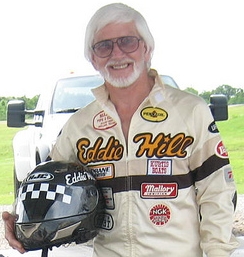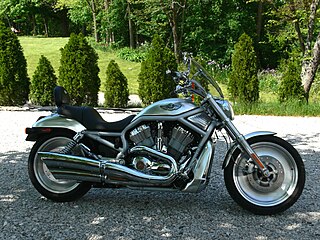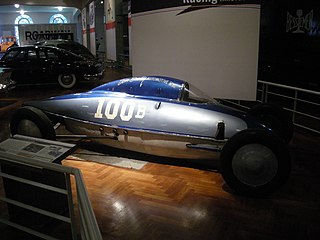Related Research Articles

Drag racing is a type of motor racing in which automobiles or motorcycles compete, usually two at a time, to be first to cross a set finish line. The race follows a short, straight course from a standing start over a measured distance, most commonly 1⁄4 mi, with a shorter, 1,000 ft distance becoming increasingly popular, as it has become the standard for Top Fuel dragsters and Funny Cars, where some major bracket races and other sanctioning bodies have adopted it as the standard. The 1⁄8 mi is also popular in some circles. Electronic timing and speed sensing systems have been used to record race results since the 1960s.

The National Hot Rod Association (NHRA) is a governing body which sets rules in drag racing and hosts events all over the United States and Canada. With over 40,000 drivers in its rosters, the NHRA claims to be the largest motorsport sanctioning body in the world.

A chopper is a type of custom motorcycle which emerged in the US state of California in the late 1950s. A chopper employs modified steering angles and lengthened forks for a stretched-out appearance. They can be built from an original motorcycle which is modified ("chopped") or built from scratch. Some of the characteristic features of choppers are long front ends with extended forks often coupled with an increased rake angle, hardtail frames, very tall "ape hanger" or very short "drag" handlebars, lengthened or stretched frames, and larger than stock front wheel. To be considered a chopper a motorcycle frame must be cut and welded at some point. I.e. the name chopper. The "sissy bar", a set of tubes that connect the rear fender with the frame, and which are often extended several feet high, is a signature feature on many choppers.

In aviation, a drop tank is used to describe auxiliary fuel tanks externally carried by aircraft. A drop tank is expendable and often capable of being jettisoned. External tanks are commonplace on modern military aircraft and occasionally found in civilian ones, although the latter are less likely to be discarded except in an emergency.

Edelbrock, LLC is an American manufacturer of specialty automotive and motorcycle parts. The company is headquartered in the Memphis area, with a Southern California R&D Tech Center located in Cerritos, CA. The Edelbrock Sand Cast and Permanent Mold Manufacturing foundries are located in San Jacinto, CA. Edelbrock has two facilities in North Carolina: the Edelbrock Carburetor Division in Sanford, and the Edelbrock Race Center in Mooresville.
Otis Victor Edelbrock, Sr. was an American automotive aftermarket performance parts engineer, racer and is considered one of the founders of the American hot rod movement Victor, known as "Vic", established Edelbrock Corporation in Beverly Hills in 1938 and is the father to Otis Victor Edelbrock, Jr., who was from 1962 to 2010 president and was CEO of the Edelbrock Corporation until 2017.
Alex Xydias was an American hot rodder, racing driver and land speed racer, active in the early days of auto racing.
Nostalgia drag racing is a form of drag racing that uses cars from earlier eras of drag racing, as well as cars built to fit the guidelines of earlier eras using parts that would have been available in that era.

The Harley-Davidson Sportster is a line of motorcycles produced continuously since 1957 by Harley-Davidson. Sportster models are designated in Harley-Davidson's product code by beginning with "XL". In 1952, the predecessors to the Sportster, the Model K Sport and Sport Solo motorcycles, were introduced. These models K, KK, KH, and KHK of 1952 to 1956 had a sidevalve engine, whereas the later XL Sportster models use an overhead valve engine. The first Sportster in 1957 had many of the same features of the KH including the frame, fenders, large gas tank and front suspension.
Dean Moon was an American automobile designer. He grew up in Norwalk, California. Moon was around cars and racing from his youth. His father owned "Moon Café" and had a go-kart track he called "Moonza", a pun on Monza. Dean was involved in dry lakes hot-rodding in the late 1940s. He founded MOON Speed Equipment (c.1950) and worked to improve the quality and safety of speed and racing products his entire life.

The Wally Parks NHRA Motorsports Museum, located in Fair plex, Los Angeles County, houses a collection of memorabilia, automobiles, and motorcycles related to the sport of hot-rodding.

Eddie Hill is an American retired drag racer who won numerous drag racing championships on land and water. Hill had the first run in the four second range (4.990 seconds), which earned him the nickname "Four Father of Drag Racing." His other nicknames include "The Thrill", "Holeshot Hill", and "Fast Eddie". In 1960, he set the NHRA record for the largest improvement in the elapsed time (e.t.) when he drove the quarter mile in 8.84 seconds to break the previous 9.40-second record.

The Harley-Davidson VRSC, or V-Rod, is a line of V-twin cruiser motorcycles made by Harley-Davidson from 2002 until 2017. They are often called muscle bikes for their relatively high power output. The V-Rods are the first street motorcycles made by Harley-Davidson with overhead camshafts and liquid cooling.

The Dunstall Norton was a Norton motorcycle made by Paul Dunstall, a specialist tuner of the 1960s and early 1970s twins originally using some parts from Norton's Domiracer project when the Birmingham factory was closed in 1963. In 1966 Dunstall Motorcycles became a motorcycle manufacturer in its own right so that Dunstalls could compete in production races, and set a number of world records before sales of the Dunstall Nortons declined in the 1970s consistent with the demise of the British motor cycle industry and a corresponding rise in Japanese imports.
Robert E. Meeks was an American hot rod engine builder and chief mechanic to famed hot rod driver and auto parts designer Vic Edelbrock. Meeks was pioneer in the early days of hot-rodding and was considered the first Ford flathead guru.

1950s American automobile culture has had an enduring influence on the culture of the United States, as reflected in popular music, major trends from the 1950s and mainstream acceptance of the "hot rod" culture. The American manufacturing economy switched from producing war-related items to consumer goods at the end of World War II, and by the end of the 1950s, one in six working Americans were employed either directly or indirectly in the automotive industry. The United States became the world's largest manufacturer of automobiles, and Henry Ford's goal of 30 years earlier—that any man with a good job should be able to afford an automobile—was achieved. A new generation of service businesses focusing on customers with their automobiles came into being during the decade, including drive-through or drive-in restaurants and greatly increasing numbers of drive-in theaters (cinemas).

Honest Charley was an American businessman and pioneer in the high performance automotive parts industry. Born Charles Edward Card Jr., he was known throughout the racing and hot rod communities by the trade name Honest Charley. In 1948 he created the Honest Charley's Speed Shop in Chattanooga, Tennessee in the United States. The company became well known for its unique and entertaining catalogs which were originally hand drawn. Honest Charley's also attracted the attention of the aftermarket parts industry for its innovative distribution techniques. He was a racing enthusiast, patron and sponsor. He was a USAC Life Time Member with member number 121 and early member of the Indy 500 Old Timers Club. In 1970 he became the second inductee into Specialty Equipment Market Association (SEMA) Hall of Fame.

A Lakester is a car with a streamlined body but with four exposed wheels. It is most often made out of a modified aircraft drop tank. The main attraction is the drop tank's excellent aerodynamics due to it being streamlined for its original use on aircraft. Building lakesters became popular after World War II when surplus drop tanks were available cheaply.
Altered is a former National Hot Rod Association (NHRA) drag racing class and a current drag racing chassis configuration that forms the basis of many classes of NHRA Competition Eliminator.
Ed "Isky" Iskenderian is an American hot rodder and entrepreneur.
References
- ↑ Madigan, Tom (2005). Edelbrock: Made in USA. San Diego: Tehabi Books. p. 324. ISBN 1-931688-18-4.
- 1 2 So-Cal Speedhop.com History Archived 2008-02-08 at the Wayback Machine
- ↑ so-calspeedshop.com Alex Xydias History Archived 2008-01-17 at the Wayback Machine Retrieved November 10, 2009
- ↑ Oilstick.com NHRA museum article Groak, Bill, 2004.
- ↑ Supercars.net article Retrieved November 30, 2009
- ↑ "2003 So-Cal Lakester". Supercars.net. 2016-04-22. Retrieved 2021-06-12.
- ↑ "Annual Quail Gathering" Cyril Huze